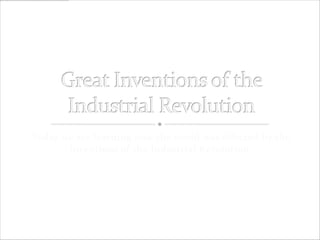
Industrial Revolution
- 1. Today we are learning how the world was effected by the inventions of the Industrial Revolution.
- 2. Arkwright’s water frame Spin yarn/thread faster/stronger than spinning jenny Too big for home operation Need for special buildings near water Need for worker in area Crompton’s spinning mule Spinning jenny + water frame Cartwright’s power loom Used steam to produce product faster than man power The Luddites Disgruntled workers feared job loss or lower wages Australia bound What does this lead to? New labor system Shift work & Rural worker issues
- 3. Mid 18th century- Eng – no forest Man/horse power – too slow Coal = answer Problem- Mines filled w/ water
- 4. Thomas Savery’s steam- powered pump Very dangerous, often exploded – no movable parts
- 5. Thomas Newcomen’s true steam-powered engine Boiler, piston, & cylinder
- 6. James Watt’s engine Fixed both Thomas’ problems Steam cool away from cylinder More efficient and produced more raw power
- 7. Before 18th century no change from Middle Ages in Iron production. Henry Cort’s puddling furnace Allowed pig(raw) iron to be refined w/coke(coal-H2O) Produced stronger iron Iron Production Stats: 1740 1780s (after Cort’s invention) 1852 17,000 tons 70,000 tons 3 million tons What does this lead to?
- 8. Iron Industry Henry Cort, puddling (produces high quality iron) Stronger iron allows for new machines, esp. trains Railroad Richard Trevithick, steam-powered locomotive George Stephenson, Rocket, 1830 Ripple effect Prices of goods fall; markets grow larger; increased sales mean more factories and machinery; thus, self- sustaining The Industrial Factory Workers in shifts Workers come from rural areas Regulations
- 9. Population Growth and Urbanization European population 1750 -140 million 1850 - 266 million Decline of death rate Less war Less disease More food Growth of cities Poor living conditions Sanitation poor
- 10. Potato crop infested w/fungus 1/3 of population depends on potato to survive 1 million people died 1 million moved to US
- 11. New Social Classes: The Industrial Middle Class New bourgeoisie/New elite Constructed the factories, purchased the machines, figured out where the markets were Reduce the barriers between themselves and the landed elite New Social Classes: The Industrial Working Class Poor working conditions 12-16 hours per day, 6 days a week Women and children Paid ½ of what men get Factory Act of 1833 – minimum age to work - 9 Efforts at Change Socialism – society (govt) owns factors of production Utopian socialists – all fail
- 12. Today we are learning about working conditions during the Industrial Revolution
- 13. Not until the 1820s Why work in a factory? Cottages works – step backwards No more setting own schedule Machinery Very dangerous
- 14. Entire families hired All worked in home, so all worked in factories Men Hardest labor Women Operated machines Children Swept Picked up scraps Worked on machines
Notas del editor
- As you now know about the inventions that were created during the Ind. Rev, now let’s take a closer look at the first factories.